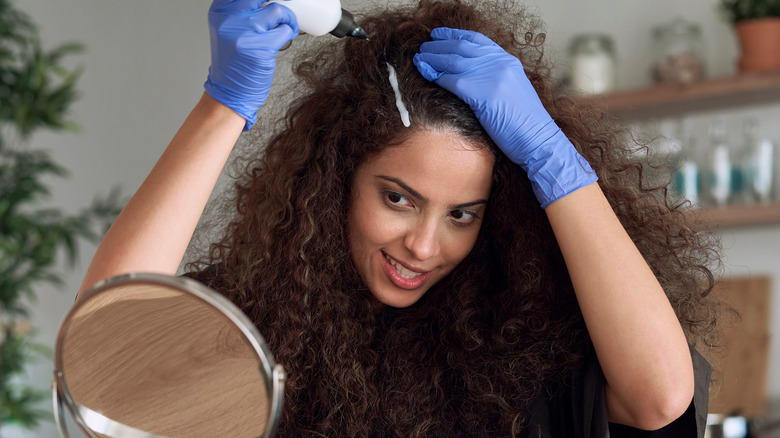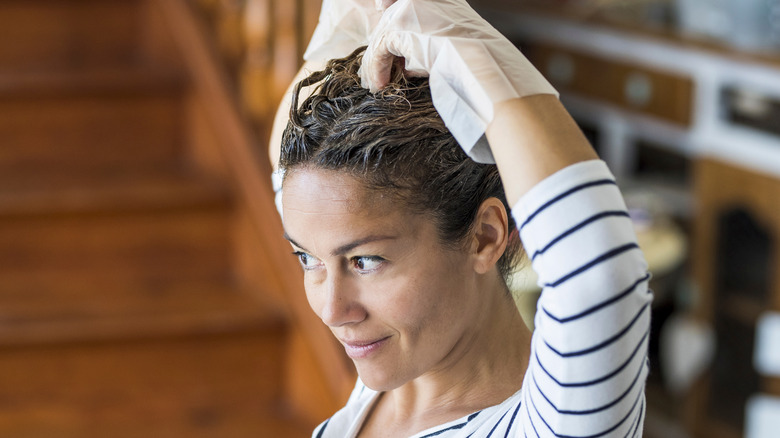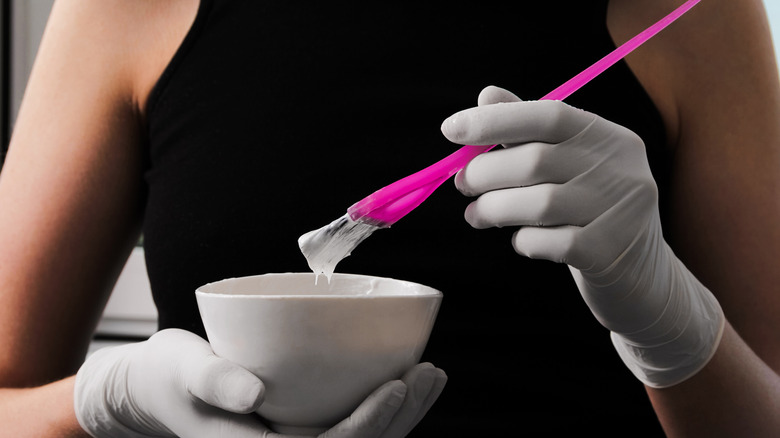How Hair Dye Affects Thin Hair Vs. Thick Hair
Dyeing your hair is fun when you're looking to change your appearance, cover up your grays, or keep up with the color you already have. While we all know that hair dye changes the color of our locks, not all of us understand what it does to the hair follicles. Coloring your hair has a specific science behind it. Applying hair dye creates a chemical reaction that pulls apart the protective proteins in your hair so that the dye can actually enter each hair strand and change your hair color (via Healthline).
Whether you use temporary, semi-permanent, or permanent hair dye, you are chemically changing the hair shaft. A dry hair strand is composed of 95% protein, so when you alter the hair's protein composition by applying dye, your hair can lose strength and thickness, and can become dry and frizzy. But does hair dye affect naturally thin hair differently than thick hair?
Hair dye damages thin hair and thick hair equally
According to Healthline, hair dye will make your hair weaker and prone to breakage, regardless of whether your hair is naturally thin or thick. The damage might be more noticeable on thinner hair, but thick hair can still see unwelcome side effects from dyeing because it requires a longer processing time. Hair Loss Specialists shared that coloring your hair doesn't necessarily lead to "long-term hair loss" but may cause short-term issues like "redness, burning, itching or raw skin, and even face swelling."
Dyeing your hair doesn't necessarily stop your hair from growing or affect your hair inside the scalp, but it damages the hair that comes in contact with the dye, per Dermatology Times. You have to play with the hair to get the color all over or specific areas that weaken the hair follicles and may lead to more hair fall than usual. "Once hair is split or broken, nothing can permanently fuse it back together," Beauty Lab Director Dr. Birnur Aral told Good Housekeeping. She suggests using hair masks or leave-in conditioners to help repair the structural damage. Thick hair, it turns out, might require a richer treatment, while thin hair can benefit from only a smoothening cream (via Matrix).The only permanent fix, unfortunately, is to cut off the damaged hair. Maybe it's just the sign you needed to cut your hair!
Chemicals in hair dye can cause health issues
If you want to color your hair no matter what, know that some chemicals used in professional and box hair dyes can damage your hair and have negative health effects. Mother Earth Living recommends checking the ingredient list and avoiding products with "P-Phenylenediamine (PPD), resorcinol, ammonia, persulfates, hydrogen peroxide, and lead acetate" because they cause health risks. Furthermore, Made Safe shared that ammonia and PPD are banned from the European Union because ammonia can cause respiratory issues, while PPD is linked with birth defects. Understanding these potential risks can help you make the most informed decision for your hair.
"Every time you color your hair, your immune system registers a foreign particle on the scalp," which can lead to a bad skin reaction, Rob Forgione, co-founder of My.Haircare, told Byrdie. You might think natural hair dyes are better for your hair, but according to Cosmopolitan, there is no such thing as natural or organic hair dyes because they use chemicals, too.
Hair dye marketing can be misleading and make you think they are undoubtedly safe, but always make sure to check their labels for their full ingredients. The most non-toxic option to add a slight tint to your hair is using natural products like coffee, chamomile, or wine, per HuffPost. Overall, hair dye will affect thick and thin hair equally by changing its color and composition, and it may even pose some health risks. Now, you just need to know if you really have thick or thin hair before you get started.


